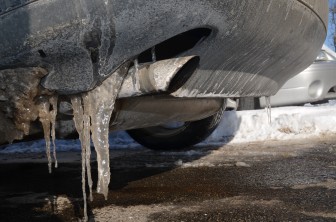 Exhaust testing in Ontario has dramatically reduced auto emissions. Photo: RJ Wolcott.
Exhaust testing in Ontario has dramatically reduced auto emissions. Photo: RJ Wolcott.
Despite its unassuming name, Drive Clean, a provincial program mandating that vehicle emission levels be tested to renew their registrations, continues to make significant health improvements, according to the Ontario Ministry of the Environment.
Since the program’s inception in 1999, ministry officials say Drive Clean has cut smog by 36 percent in the province, stopping nearly 35,000 tons of poisonous vapors from entering the atmosphere each year. The program has helped Ontario eliminate more than a third of all automobile pollution, according to Kate Jordan, communications officer for the ministry.
The program continues to be relevant, Jordan said.
“These emissions reductions are important as vehicle emissions are responsible for more than 18 percent of smog-causing pollution created in Ontario, despite today’s cleaner vehicles and fuels,” Jordan said. “Emission technologies in vehicles, no matter how advanced, can deteriorate over time.”
Recent program upgrades, including replacement of tailpipe tests with computerized testing, mean motorists get more accurate results faster, according to Jordan.
That doesn’t mean the program is without its critics.
Joel Wood, associate director of the Centre for Environmental Studies and Centre for Risk and Regulation at the Fraser Institute in Vancouver, cited a study by the University of Guelph which revealed a number of problems within Drive Clean.
The institute is a public policy think tank.
Researchers found many vehicles are tested too often, despite continually passing inspection and said that the program could be scaled down without a discernible adverse impact on emissions. Wood also noted that AirCare, the British Columbia inspiration for Drive Clean, ended because of a lack of impact.
“Cars have become much cleaner over time due to technological improvements and emissions standards on new cars imposed at the federal level,” Wood said. “British Columbia found that the percentage of cars failing the test had become too small to justify the program’s continuation.”
Vehicles built before 1988 are exempt from the Ontario program, as are vehicles designated as historical under the Highway Traffic Act. Those exceptions lead many critics to say the program isn’t making the environmental impact it was intended to.
Other critics point out that while the program was initially designed to break even financially, it now generates more than $19 million after expenses annually ($17,120,210 US). To stem the surplus, ministry officials reduced testing charges from $40 to $35 beginning April 1.
Despite these concerns, the program boasts impressive numbers. Aside from reducing toxic chemicals from vehicle emissions such as nitrogen and sulfur oxides, Drive Clean has prompted more than four million vehicles to undergo repairs to stem air pollution.
Heavy-duty non-diesel vehicles have the lowest test passage rate, representing about 80 percent of the more than 22,000 vehicles failing since the program began. Light-duty petrol and heavy-duty diesel vehicles have higher success rates, with 88 percent and 96 percent of vehicles falling within acceptable emissions limits.
Environmental groups within the Canadian Network for Human Health and the Environment stand behind the project’s efforts to reduce air-borne pollution.
“Since the Drive Clean program was implemented, there’s been a noticeable decrease in vehicle emissions across the province. With less air pollutants in the air, this is good news for Ontarians, especially those with lung disease such as asthma and chronic obstructive pulmonary disease (COPD),” said Connie Choy, air quality and asthma coordinator for the Ontario Lung Association.